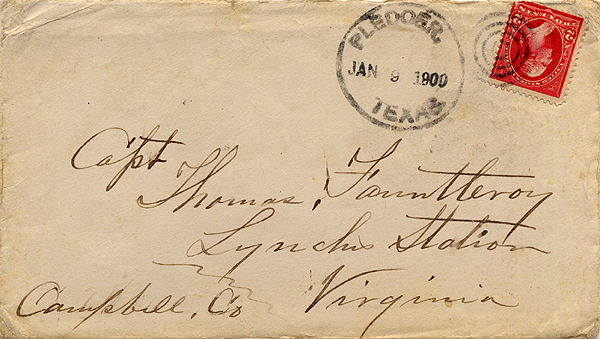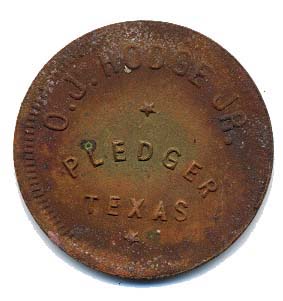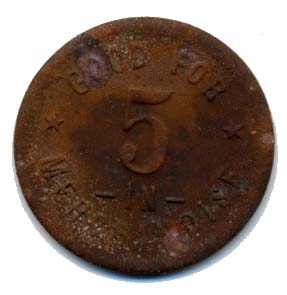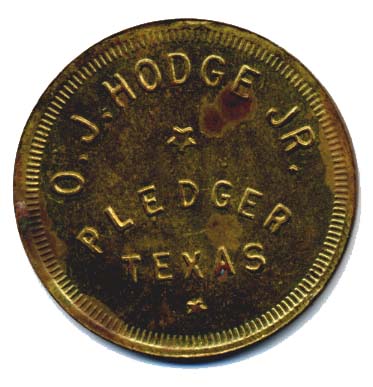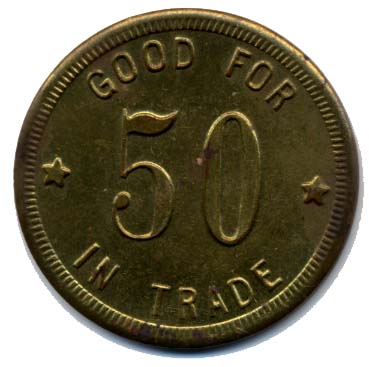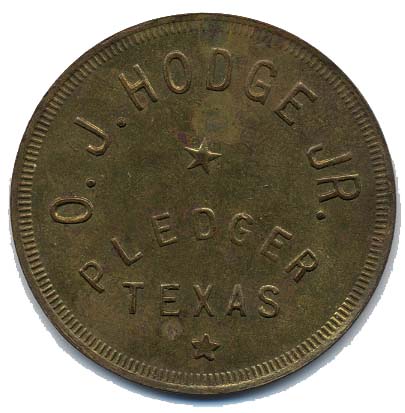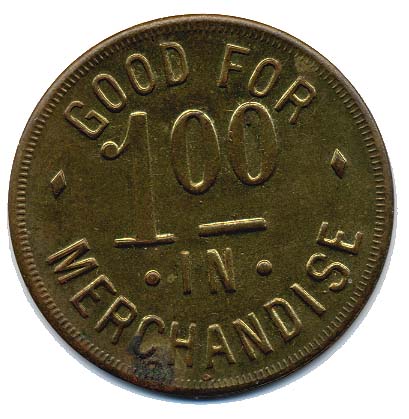|
|
|||||||||||||||||||||||||||||||
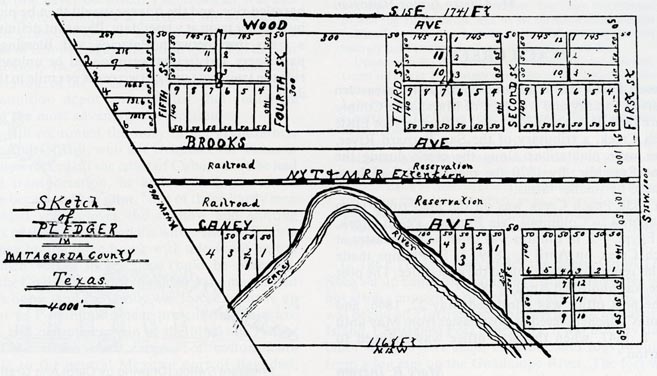 |
|||||||||||||||||||||||||||||||
|
Today, 1986, the Pledger community, a thirty-six square mile area, is situated in the northeast corner of Matagorda County. The Pledger townsite, which was platted and filed on March 3, 1902, is about seventeen miles south of Wharton, seventeen miles north of Bay City, and seventeen west of West Columbia. FM 1301, which connects Wharton and West Columbia, passes through the townsite. FM 1728, which begins at FM 1301 in Pledger goes south toward Sugar Valley and Bay City. The railroad passing through Pledger is practically abandoned. Pledger remains primarily an agricultural community. Products include pecans, turf grass, grains, soy beans, hay, livestock and cotton. The Florida Gas Company, which maintains a sizeable facility, is the only nonagricultural industry in the community. Pledger is becoming a "bedroom" community for workers in Houston, Wharton, West Columbia, Bay City, Old Ocean, Freeport and the STNP. The population of Pledger is approximately 500 persons; the 1983 tax value, $22,929,607; the 1983 school tax, $178,850; and the 1983 county tax $135,284. Although the present townsite was not platted until 1902, the area has been served by post offices named Pledger since May 17, 1880. It appears that the poistmasters may have moved the post office from place to place within the Pledger area, but the Pledger name has remained to identify the area. The postmasters were:
On August 31, 1877, the Pledger area was further identified:
On May 23, 1827, Stephen F. Austin granted Lawrence Ramey one league (Survey 14, Abstract 79) out of which he sold 300 acres to Celia Shrock. Celia Shrock subsequently sold this 300 acres to Mary Ann Dalton Pledger, widow of William E. Pledger and mother of Narcissa D. and Ann Eliza Pledger. Narcissa D. Pledger and Dr. John W. Brown were married on March 3, 1862, by John Owen, Rector of Christ Church, Matagorda. All Eliza Pledger sold her interest in the 300-acre Pledger Plantation to her sister, Narcissa D. Brown, on December 10, 1862. The deed recited that she was conveying her interest, "as one of the surviving heirs of my mother, Mary Ann Pledger, deceased, and the surviving heir of my deceased brothers and sisters." After Narcissa's death in March, 1867, Dr. Brown sold 50 of the 300 acres, and on June 1, 1896, he transferred the remaining 250-acre Pledger Plantation to his daughter, India Brown. India Brown died April 12, 1925, at Calvert, Texas, and her granddaughter, Lucy Ellen (Field) King, inherited the Pledger Plantation. Lucy King still owns the plantation. In view of the foregoing, it is concluded that the name "Pledger" came from the Pledger family; however, the post office was named "Pledger" by Dr. John W. Brown in 1880 in memory of his deceased wife, Narcissa, and her parents. Property owners in the Lawrence Ramey League in the middle 1800s included R. R. Royall (1,107 acres); Mary Ann Cage, wife of Benjamin Cage, (1,107 acres); John M. Cayce (500 acres); Mary Ann Dalton Pledger (300 acres); Samuel B. Bingham (640 acres); and Lawrence Ramey (866 acres). At about the same time, Dr. Brown owned most of the Zadock Woods League, except for 572.25 acres in the northeast corner owned by the Lawsons and 572 acres just south of the Lawson tract owned by the Loverins. The dividing line between the Lawson and Loverin tracts was a trail which ran east through the Pledger Plantation to Brazoria. The trail to the south and west passed through the Brown Plantation to Brazoria. The trail to the south and west passed through the Brown Plantation to Podo, McCrosky, and Matagorda. Remains of this trail and the Brown Plantation home and commissary remained as late as the 1930s. In a deed from H. J Bolton to the Wharton Gin & Milling Company, dated November 30, 1900, what is now called Block 5, Pledger townsite, is referred to as being "in the town of Lane." Between 1827 and 1894 title to the land in the Zadock Woods League was often held by five or less people, but from 1853 to 1894, Dr. Brown was one of these owners. Others were John H. Lawson, William H. Loverin, M. D. Hardeman, U. C. Coolgrove, a Mr. Sorsby and a Doctor Searcy. By May 8, 1900, Dr. Brown 3,299 acres in the Z. Woods League which was purchased by Judge G. G. Kelly, R. B. Huston, J. H. Bolton, H. G. Forguson (Forgason) and G. C. Clifford, all of Wharton. The buyers divided the property into five acre tracts and drew lots. Judge Kelly drew tract #1 which his descendants still own. The balance of the land eventually became the property of the United States Bond and Mortgage Company (USB&M) of Dallas, Texas, (2,411 acres) and the Victoria Land and Loan Company (494 acres). In 1921 the USB&M acquired the 2,411 acres, then known as the Garland Plantation or Bobcat Plantation in 1921, from Daniel N. Garland and wife, Inez C.; Mary Garland, Daniel's sister; and J. C. Barr and wife, Ollie Lou Barr, who had acquired the land in 1916. The Garlands and Barrs lived on the plantation, and J. C. Barr operated a cotton gin at Forgason Switch situated on teh railroad about one mile south of Pledger. "The Strand," "Cool Grove," and "Grove Hill," are names used to describe locations in teh Pledger community, which are almost forgotten. "The Strand" was used to describe the trail between Wharton and Matagorda counties that joined the trail from Pledger to Brazoria. On "The Strand," near the Pledger Plantation, one still could find traces of old bricks and machinery as late as 1930. "Cool Grove" was used to describe the area around Dry Bayou as it flows from Wharton to Matagorda County. This is the area where H. C. Coolgrove lived after he purchased the 572-acre Lawson tract in December, 1860. "Grove Hill" was the area near the Brown plantation homesite. It was the site of the original "Grove Hill" church which was also used as a schoolhouse by the slaves and their descendants. The old church is now gone, but the cemetery remains in use today by the members of the Grove Hill Missionary Baptist Church which is now situated in Block 1 of the present Pledger townsite. In the 1894-1895 Matagorda County School Census, State of Texas, abstracted by the Matagorda County Genealogical Society in 1982, there were 53 black children between the ages of eight and sixteen listed in 1894 and 41 in 1895. There were only eight names of white children from three families who attended the "School Community--Pledger." During the middle 1830s, ownership of the other three leagues, Charles DeMoss, Peter DeMoss and Benjamin Rawls and O. H. Stout, was probably by a Mr. Pierce and a Mr. Duncan. All that is known for certain is that many of the black residents now living in the Pledger area claim to have been born, or claim their ancestors were born in the Charles DeMoss, Peter DeMoss or Benjamin Rawls and O. H. Stout leagues. They or their ancestors worked on the Duncan and Pierce farms and ranches in these leagues near the Zadock Woods League. Caney Creek meanders southwestward through the middle of the Z. Woods League, then through the northwest corner of the Peter DeMoss League, the southeaster part of the Charles DeMoss League, then through the eastern portion of the Rawls and Stout League. The land extending from teh high banks of Caney Creek to the lower bottomlands is extremely fertile and easily tilled. These are the lands where communities such as Pledger, Podo, Ashwood, Sugar Valley and Allenhurst were established and the lands chosen by landowners like Dr. Brown to build homesteads and cultivate crops. Crops during the early 1900s consisted of sugar cane, cotton and corn. During the 1920s, several attempts were made to "truck farm." Unfavorable weather conditions convinced the farmers in the Pledger area that cotton and corn were more profitable than truck farming, and by 1930 practically all truck farming had stopped. Cotton was king in the 1920s and 1930s, and there were as many as three cotton gins in the Pledger area. Also during the 1910s and 1920s, a pipeline was laid from the Damon oil fields to Pledger. Crude oil loading racks were erected along the railroad sidings at Pledger where railroad oil tank cars were filled and shipped to refineries. At least one cotton gin burned oil in its boiler to develop the steam power for gin operations. The roaring 1920s were followed by the Great Depression of the 1930s. Since most of the Pleger residents, blakc and white, were tenant farmers, the Great Depression had little effect upon their lives. They were poor hard-working survivors before the depression, during the depression and after the depression. The land provided food so none were hungry. Homemade clothes were the style before, during and after the depression. There was always plenty of fuel (wood) to warm the shanties provided for tenants. Although cotton prices dropped to 4 cents per pound, most human needs could be supplied without money. All tenants had a fresh milk cow, a few pigs, and the woods and the farm supplied other human needs. Even during these times, Pledger had two general merchandise stores. They bought eggs, cotton, pecans, corn, cow hides, wild animal furs, and other products from their customers for shipment to markets. In turn their customers purchased farming equipment, hardwares, dry goods, and food staples. The Hodge family came the community in 1913 and have continued to operate a mercantile business form 1913 to date [1986]. The other store was first operated by W. D. Winn. It changed hands several times but finally burned and closed its doors. With the Boling oil boom of the late 1920s and early 1930s, followed by the opening of the sulphur mines at New Gulf, the economy of Pledger improved for the storekeepers and day laborers. Also about this time the Danciger oil field was brought in by a driller named Claud Crone. It has been in operation since that time and has contributed to the Pledger economy. In the early 1940s, 2,411 acres of the old Brown Plantation, which has passed into the hands of the USB&M, were divided into fourteen smaller farms of 95 to 260 acres each and one farm of 564 acres and sold to: Albert Bender, Claud B. Barnes, Herman E. Scholz, James L. Reves, Jim Janota, John P. Dornak, Ben Salas, William V. Gajdosik, Albert R. Bender, John E. Rousseau, Charles C. Sherrill, Alvin Rolf, B. F. Chumchal, Henry Kubosh and J. O. Sherrill. Except for the G. G. Kelly tract of 656 acres, the balance of the Z. Woods League was owned by local residents: H. H. Hall (119.5 acres), Sandor Horvath (125 acres), O. J. Hodge, Jr. (460 acres), B. R. Viktorin (494 acres) and some nine other tracts of less than 50 acres each. In 1947 all public schools in the Pledger area (black and white) consolidted with the Boling School District. This provided the Pledger children with a better education, but it took the "glue" out of the community that held the residents together. With the loss of the public school buildings, the residents had no public building in which to hold meetings; however, thorough the dedicated efforts of Hawthorne E. Amey, Johnnie Jackson, J. O. Sherrill, Floyd Amboree and Dexter L. Hodge and the financial and moral support of all citizens in the area, the county decided to construct a county fire station and polling place on the corner of Wood Avenue and Fourth Street. This facility was dedicated by County Precinct #1 Commissioner Otha "Skeet" Birkner November 4, 1974.
|
|||||||||||||||||||||||||||||||
|
